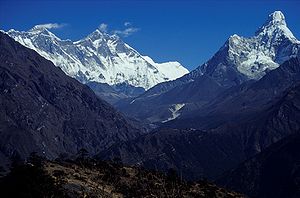Ama Dablam
| Ama Dablam |
|---|
Ama Dablam is a mountain in the Himalaya range of eastern Nepal. The main peak is 6,812 metres (22,349 ft), the lower western peak is 5,563 metres (18,251 ft). Ama Dablam means "Mother and Pearl Necklace" (the perennial hanging glacier is thought of as the pearl). For several days, Ama Dablam will dominate the eastern sky for anyone trekking to Mount Everest.
Ama Dablam was first climbed on March 13, 1961 by Mike Gill, Barry Bishop, Mike Ward and Wally Romanes via the SW ridge.[2]
The normal climbing route is via the southwest ridge (right skyline in the photo). Climbers will typically set up three camps along the ridge with camp 3 just below and to the right of the hanging glacier (Dablam). Any ice that calves off the glacier typically goes left, away from the camp. However, a 2006 avalanche (see below) proved otherwise. A climbing permit and a liaison officer are required when attempting Ama Dablam. As with Mt. Everest, the best climbing months are April-May (before the monsoon) and September-October.
The mountain was originally used by Invesco Perpetual as its branding logo within UK. It has since been adopted by the INVESCO group of companies as its worldwide signature.
2006 Avalanche

On the night of 13/14 November, 2006, a large serac collapse occurred from the hanging glacier, which swept away several tents at Camp 3, killing six climbers (3 European, 3 Sherpa). Eyewitness testimony indicates that Camp 3 had not been sited in an unusual or abnormally dangerous spot, and that the serac fall was of such magnitude as to render the specific placing of the tents at Camp 3 irrelevant.[3]
References

- ^ "Ama Dablam". Peakbagger.com. Retrieved 2009-03-01.
- ^ "Ama Dablam 2005". EverestNews.com. Retrieved 2009-03-01.
- ^ "Ama Dablam avalanche testimony". MountEverest.net. 2006-11-17. Retrieved 2006-11-24.
External links
- Nepal Expedition Trips 2009 – Ama Dablam Expedition.
- Ama Dablam on Summitpost
- Ama Dablam on Peakware
- Mountain Magazine - Climber's Database - World Mountain Database - News - Ama Dablam
